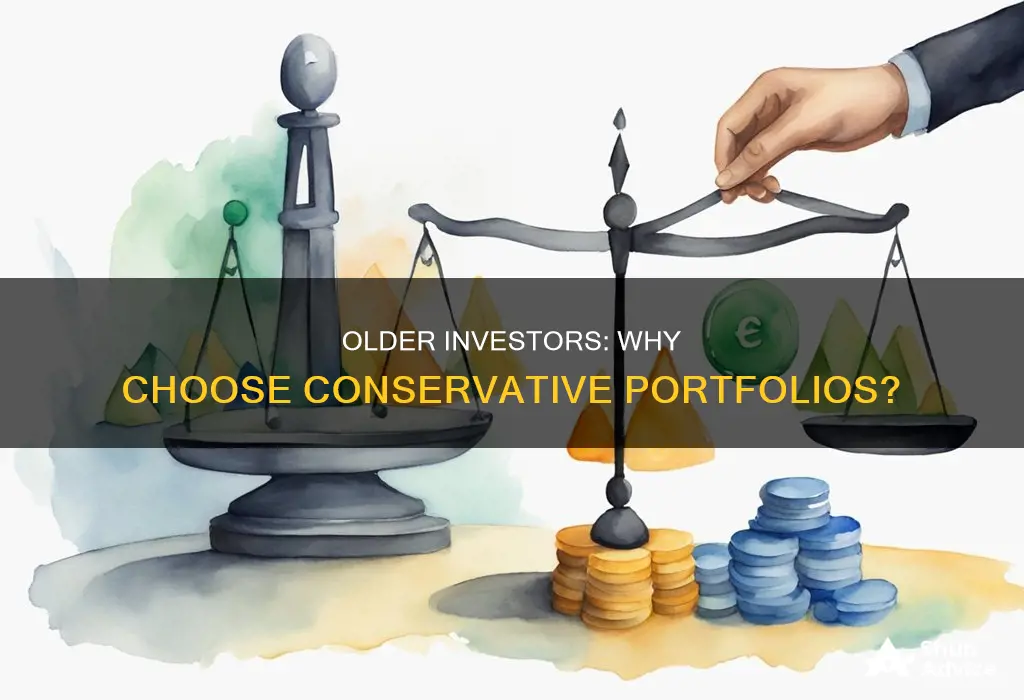
As people age, their investment portfolios should become more conservative. Older people are advised to reduce the risk in their investment portfolios because they no longer have the rising incomes of a full-time job, and they have less time to recover from losses. A more conservative portfolio will help older people preserve their capital and generate income.
What You'll Learn

Peace of mind and low risk
As people age, their investment portfolios should become more conservative. Older people have less time to recoup losses from high-risk investments. Therefore, a conservative investment portfolio is ideal for older people seeking peace of mind and low risk.
A conservative investment portfolio focuses on capital preservation rather than growth. This type of portfolio typically includes low-risk, low-return investments that generate passive income in the long term without exposing the investor to high-risk investments such as stocks.
Older people may also have less income to invest, as they are no longer working full-time. This makes it even more important to choose low-risk investments that protect their capital.
There are several safe and stable investment options for older people seeking peace of mind and low risk. These include:
- FDIC-insured accounts: These accounts offer peace of mind as they are federally protected. FDIC insurance covers deposits up to $250,000 for certain investment options.
- High-yield savings accounts: These accounts offer higher interest rates than traditional savings accounts, helping to grow money passively. They are also FDIC-insured, so there is little risk of losing money.
- Certificates of deposit (CDs): CDs are considered one of the safest investment options as they offer a fixed interest rate over a fixed period. They are also FDIC-insured and can be purchased at banks, brokerage firms, and credit unions.
- Treasury bills, notes, bonds, and TIPS: These are good short-term investment options that provide a steady income with low risk.
- Dividend-paying stocks: Well-established companies pay dividends to shareholders, providing a more consistent income source.
- Money market accounts: These accounts offer higher interest rates and incentives for larger deposits. They are also FDIC-insured and provide easy access to funds, making them a good option for retirees.
By choosing a conservative investment portfolio with these types of investments, older people can have peace of mind and low risk while still generating income and preserving their capital.
Building a Wine Investment Portfolio: A Beginner's Guide
You may want to see also

Passing money to family members
Peace of Mind and Financial Security
Conservative investment portfolios tend to have modest goals and focus on preserving wealth. This approach can provide peace of mind and financial security for older individuals who want to ensure they have enough funds to pass on to their family members. By minimising risk and seeking to maintain their capital, they can feel confident that their investments will remain stable and available for their intended purposes, including leaving a financial legacy for their loved ones.
Long-Term Planning
As people age, their investment horizons shorten, and they may adopt a more conservative outlook to protect their current financial assets. This strategy is particularly relevant for older individuals who want to pass money to their family members as part of long-term planning. By investing in lower-risk securities, they can aim to preserve their capital and generate steady income, ensuring that their financial resources are available when needed, whether for their own retirement or for distribution to family members.
Minimising Risk
Conservative investment portfolios typically include a high weighting of low-risk securities, such as government bonds, money markets, and cash equivalents. This approach is well-suited for older individuals who want to minimise risk while still generating some returns. By investing in these secure options, they can aim to preserve their capital and protect it from significant losses, ensuring that the funds remain available for passing on to family members.
Current Income Strategies
Conservative investment strategies can include a focus on current income, making them appropriate for older investors seeking a steady flow of money during retirement. These strategies involve investing in established entities that consistently pay dividends or interest. This approach can provide a reliable income stream, allowing older individuals to maintain their financial stability while also having the flexibility to distribute funds to family members as needed.
Defensive Strategy
In some cases, older individuals may temporarily adopt a conservative strategy if they anticipate negative market movements. This defensive approach involves shifting to safer assets to protect their capital. By doing so, they can safeguard their investments and reduce the risk of losses, ensuring that their financial resources remain intact for both their retirement needs and any plans to pass money to family members.
Savings-Investment Spending Identity: Lessons for the Economy
You may want to see also

Paying for long-term care
As people age, the need for long-term care becomes a more pressing concern. In the US, someone turning 65 has a 70% chance of requiring some form of long-term care, which can be financially, physically, and emotionally taxing. The average duration of long-term care services is three years, and the national median cost of a private room in a nursing home is $9,584 per month for 2023. These expenses can quickly deplete one's savings, making it crucial to explore various options for covering these costs.
Government Assistance:
Veterans, low-income individuals, and those who cannot afford long-term care expenses may be eligible for government assistance through programs like Medicaid and the Veterans Health Administration. However, qualification is means-tested, and benefits and eligibility vary across states.
Traditional Long-Term Care Insurance:
Traditional long-term care insurance policies allow individuals to choose the amount of coverage, duration, and waiting period before receiving benefits. While this option provides flexibility, it can be expensive, and many insurance companies no longer offer these policies due to challenges with premium increases on older policies.
Hybrid Policies:
Hybrid insurance policies combine life insurance and long-term care coverage. They often have fixed premiums for life and may include a continuation-of-benefits rider for lifetime or unlimited long-term care benefits. However, purchasing a hybrid policy may require a substantial upfront lump-sum payment.
Personal Savings:
Using personal savings to pay for long-term care can provide flexibility, but it is essential to consider if your retirement plan can withstand these expenses. Additionally, there may be tax ramifications for withdrawals from qualified retirement accounts like 401(k) or IRA.
Conservative Investment Portfolios:
Older individuals may opt for conservative investment portfolios to reduce risk and preserve their capital. This approach focuses on stable, low-earning funds like bonds and money market accounts. High-yield savings accounts, certificates of deposit, and dividend-paying stocks are also considered safe investment options for seniors.
When planning for long-term care, it is advisable to consult a wealth management specialist or a financial planner who can provide personalized advice based on your specific circumstances and goals.
Investing at 25: Building a Balanced Portfolio for the Future
You may want to see also

Reduced income in retirement
As people get older, their income often decreases as they transition into retirement. This reduced income means that retirees cannot afford to take as many risks with their investments, as they have less money to play with and less time to recover from any losses.
A conservative investment portfolio is a good option for older people as it focuses on capital preservation rather than growth. This type of portfolio usually includes safer investments, such as bonds, which provide a sure pay-off. While stocks can be included in a conservative portfolio, the ratio of stocks to bonds is lower than in more aggressive portfolios. This allows retirees to still benefit from the high rewards of stocks, while also maintaining a level of security.
Conservative portfolios are also a good option for older people who are risk-averse. While younger investors can afford to take more risks as they have time to ride out any lows in the market, older people may not feel comfortable with the stress and uncertainty that comes with high-risk investments.
Additionally, older people may be looking to pass their money on to family members or pay for long-term care, so they need to make sure they don't lose their savings through high-risk investments. A conservative investment portfolio can provide peace of mind and help older people earn money with minimal risk.
Traders' Transparency: Publicly Sharing Their Investment Portfolios
You may want to see also

Less time to recover from losses
As people get older, they generally have less time to recover any losses they might incur from high-risk investments. This is why older people tend to opt for conservative investment portfolios.
When you are younger, you can afford to take more risks with your investments because you have more time to recover any losses. For example, if you are in your twenties, you can invest 80-90% of your portfolio in stocks and 10-20% in bonds. This is because you have more time to absorb the fluctuations of the market.
However, as you get older, you have less time to recover any losses, so it is generally recommended that you reduce the proportion of high-risk stocks in your portfolio and replace them with safer bonds. This way, your portfolio can accommodate safer investments and focus on capital preservation rather than growth.
For example, if you are in your thirties, you might want to consider investing 70-80% in stocks and 20-30% in bonds. This allows you to still bear high risk but adds some bonds to your asset mix for future security.
When you are in your fifties and sixties, you are very close to retirement, so it is beneficial to focus more on capital preservation than growth. At this stage, stocks can constitute 40-50% of your assets, while bonds, cash, and other liquid equivalents make up the rest.
Once you are retired, you may prefer a more conservative allocation of 50% in stocks and 50% in bonds. This can be adjusted according to your risk tolerance—if risk makes you nervous, you can decrease the percentage of stocks and increase the percentage of bonds.
Overall, as people get older, they tend to have less time to recover from any losses they might incur from high-risk investments. This is why it is generally recommended that older people invest in conservative investment portfolios that focus on capital preservation rather than growth.
Reviewing Your Investment Portfolio: A Comprehensive Guide
You may want to see also
Frequently asked questions
As people get older, their risk tolerance decreases, and they can't afford any wild swings in the stock market. A conservative investment portfolio can provide a more stable income stream with minimal risk.
A conservative investment portfolio typically includes a combination of stocks, bonds, and cash. The exact allocation depends on the individual's risk tolerance and financial goals.
Age is a primary consideration when managing investment portfolios. Generally, the younger you are, the more aggressive your portfolio can be, while older investors should adopt a more conservative approach.
Conservative investments include high-yield savings accounts, certificates of deposit (CDs), treasury bills, bonds, dividend-paying stocks, and money market accounts.
Conservative investment portfolios focus on capital preservation rather than growth. This helps retirees protect their retirement funds and generate a stable income.







